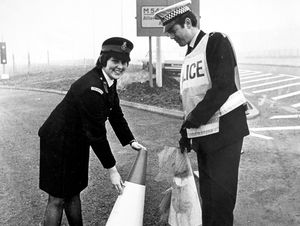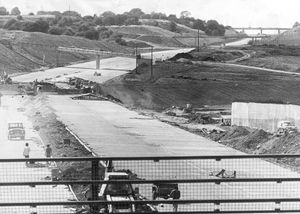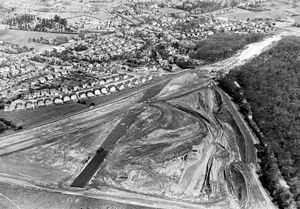1975 - Trials and tribulations of M54's development
What Telford wanted was a motorway. What it got on December 11, 1975, was Wellington bypass – a nightmare to build, and a nightmare to maintain.

Blighted by roadworks to try to put things right, in the end they more or less had to build it all over again.
That is not to say that it was useless. It was a short motorway and it did bypass Wellington and so was able to take the heavy traffic which clogged up the old A5 road, which was particularly busy during the summer with motorists from the West Midlands heading for the Welsh coast.
And while the M54 Wellington bypass was not linked up to the rest of the motorway network, it would have to do for the time being.
Shropshire's first stretch of motorway was opened on a foggy Thursday, so from the start the hazard warning lights were on. Workmen lifted the barriers at 12.10pm as police radioed to officers at each of the interchanges to ensure all side roads were opened simultaneously. The opening had been delayed for 10 minutes as police made sure that the road was clear of all contractors' vehicles.

The new road, which cost the taxpayer more than £11 million, had been scheduled to open the previous January, but was dogged by construction problems.
Much of the delay was down to unpredictable underground conditions met by contractors Gleeson in an area riddled with old mine workings. The difficulties presented major engineering problems and a great deal of ground had had to be strengthened to prevent subsidence of the road surface, which was made of concrete.
It led to 2.9 million cubic metres of material being excavated, much of which had to be carried away and dumped because it was unsuitable for inclusion in the work. More than a million cubic metres of material was eventually "imported".
These problems during construction proved to be a portent of things to come.
The project included 17 miles of fencing and 32 miles of drains.

The road ran for 4.5 miles, starting in Hollinswood – that was how it was reported, but actually traffic joined using a slip road between the Hollinswood and Priorslee traffic islands – and running south of Wellington to Cluddley in the west, where traffic linked up to the A5.
The aim was that eventually the Shropshire motorway would link up with the M6, which is of course what happened, with the M54 being extended 18.6 miles eastwards and linking up with the M6 to join the national motorway network in November 1983.
The Wellington bypass, as this initial stretch of the M54 was often known, had originally been planned to be a two-lane dual carriageway, but traffic studies showed that anticipated traffic justified it being of motorway standards, and the scheme was upgraded accordingly.
Oddly for such a short motorway, it began from the east as three lanes, from Hollinswood to the Ketley interchange, and then dropped down to two lanes as it ran from the Ketley interchange westwards towards Cluddley.
Motorists were given an unusual tip for checking the accuracy of their speedometer. The roadside marker posts were at 100 metre intervals, making eight for half a mile, and meaning if they drove at a steady speed and passed the eighth one in 30 seconds they would be doing 60 miles an hour.
The Wellington bypass proved to be just one big headache. This is what John Carrington, the former group engineer (construction) in the Midland Road Construction Unit headquarters says in his book The Motorway Achievement: "There were elements of the design that left much to be desired. The bridges in particular were poor, both from the point of view of constructional detail and aesthetics.
"The specification used for the sub-base was inappropriate. Build quality was also poor with the carriageway starting to break up after only two years. This was not helped by the decision to go for a choice of flexible or rigid construction in the tender.
"MRCU HQ had made strenuous efforts to have the rigid option dropped due to the high incidence of old mine workings along much of the route.
"Short term economics at Marsham Street (i.e. the Department of Transport) and the Treasury once again prevailed. Over the 15-year period after opening, almost all the original concrete carriageway had to be replaced. The whole length has now been covered with HRA (hot rolled asphalt).
"It also has to be said that relationships between the contractor and the resident engineer during this contract were not good."





